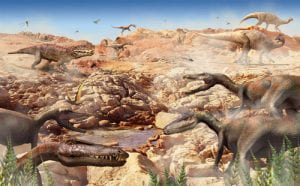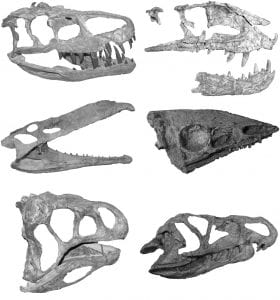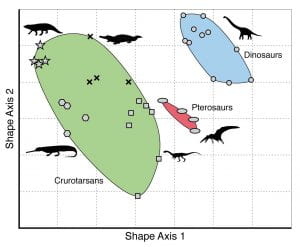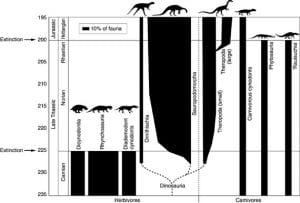Scientists have long been interested in the origin and initial diversification of dinosaurs. These creatures dominated terrestrial ecosystems for well over 150 million years, and evolved into a range of different shapes and sizes, from gigantic predators to armoured herbivores and long-necked behemoths. But what allowed dinosaurs to become so successful and dominant? Was there something special about dinosaurs which helped them rise to prominence? The answers to these questions cannot be found by focusing our attention on majestic creatures such as Tyrannosaurus rexor Brachiosaurus. Instead, scientists must look deeper in time, and try to understand exactly what was going on when dinosaurs first evolved in the Late Triassic (225 million years ago).

Life in the Late Triassic: some of the first dinosaurs: the early theropods Coelophysis in the foreground, and a basal sauropodomorph at the right, menaced by a crurotarsan predator. Credit: image from Brusatte, S. L. 2008. Dinosaurs. Quercus Publishing, London.
The rise of the dinosaurs
Some of the earliest dinosaurs include animals like Herrerasaurus and Eoraptor: fairly small, bipedal predators that lived about 225 million years ago in what is now Argentina. From animals such as these evolved the enormous range of dinosaur diversity: a menagerie of species large and small, fast and plodding, predator and herbivore, which ruled the earth for 160 million years. However, much of this diversity was not apparent during the Triassic. How did dinosaurs evolve during the early part of their history?Paleontologists have proposed two basic models to describe the early period of dinosaur evolution. These can generally be called the ‘competitive’ and ‘opportunistic’ models. The first suggestion holds that there was something inherently special about dinosaurs – perhaps warm-blooded metabolism or upright and fast locomotion – that enabled them to outcompete other reptile groups that lived during the Late Triassic. The second model posits something quite different: that dinosaurs weathered one or several mass extinctions, which knocked out other Triassic vertebrates. This hypothesis holds that there was nothing inherently special about dinosaurs, only that they were able to weather the storm during periods of intense environmental trauma.
Testing the models: Previous work
Scientists have argued about these ideas for several decades, and many giant figures in palaeontology (Alfred Romer, Bob Bakker, Alan Charig, etc.) offered their own expert opinions. However, much of the debate has been little more than hot air, since grand notions such as ‘competition’ on a 50-million-year time scale are very difficult to test critically. Only two pieces of evidence have been used to assess the models: diversity and abundance. Diversity refers to the number of different species in a group. During the Late Triassic it is clear that dinosaur diversity was low, and was dwarfed by the diversity of other reptile groups. In terms of abundance, the number of individual animals in an ecosystem, dinosaurs show variable figures – at first they were quite rare, but became relatively abundant in certain faunas of the Late Triassic.

Skulls of crurotarsans, from top left to bottom right: the rauisuchian Batrachotomus, the poposaurid Postosuchus, the phytosaur Nicrosaurus, the stagonolepidid (aetosaur) Aetosaurus, the toothless ctenosauriscid rauisuchian Lotosaurus, and the ornithosuchid Riojasuchus
What exactly were these other groups? There were several, but the most important were the crurotarsans, an assemblage of animals closely related to modern crocodiles. However, while living crocodiles are a relatively conservative bunch, Triassic crurotarsans included a menagerie of species, from heavily armored and herbivorous aetosaurs to long-snouted phytosaurs and the large, predatory rauisuchians. Many of these animals were very similar to dinosaurs in their size, diets, and locomotion. In fact, for several decades, scientists have frequently confused dinosaur and crurotarsan fossils. However, despite the great similarity of these two groups, dinosaurs and crurotarsans had vastly different fates. While dinosaurs took off and eventually dominated the world and evolved into birds, crurotarsans are today represented only by crocodiles.
Thus, it is clear that over the 30 million years of the Late Triassic dinosaurs were living alongside a very similar group of animals. The two groups were almost certainly competitors, but again, how can we assess their evolutionary interactions? Why did dinosaurs win out and crurotarsans fade away to almost nothing? Were the dinosaurs superior competitors, or was it something else?
Testing the models: disparity and diversity change
When it comes to assessing evolutionary patterns in deep time, it is important to get a sense of how fast groups are changing (rates of evolution) and what range of body plans and lifestyles (morphological disparity) they are exploiting. But, quantifying these measures is difficult. It has been done for some marine invertebrate groups such as crinoids and gastropods, but the complexity of the vertebrate skeleton makes it quite tricky to quantify body plans and rates.We compiled a database of nearly 500 features of the skull and skeleton, and noted the variation present in a range of dinosaurs, crurotarsans, and other reptiles across the Late Triassic and Early Jurassic. Our aim was to compare the evolutionary rates and range of body plans in these competing groups during the first 50 million years of dinosaur history.
Evolutionary rate is a fairly intuitive measure, and there are many ways to it, but in this case we were interested in how fast the skeletons of dinosaurs and their crurotarsan competitors were changing. We mapped all of the characters in our database onto a new phylogeny of Archosauria (the larger group that includes dinosaurs and crurotarsans). Perhaps surprisingly, we found that dinosaurs and crurotarsans were evolving at nearly identical rates during the Late Triassic. Neither group was outperforming the other, and they were keeping pace over their 30 million years of shared history.
Morphological disparity, or range of body plans and lifestyles, is perhaps less intuitive. This measure attempts to quantify the entire spread of an animal’s body designs, diets, and lifestyles – in other words, its range of adaptations. It can be measured from the same database of characters, using statistics that describe how similar and different species are from each other. A large disparity means there is a great difference between species in a group, whereas a smaller disparity means most species are quite similar to each other. These measures can be plotted on a graph known as a ‘morphospace.’ A large region of morphospace means that species are exploring a variety of different body designs. A smaller region, on the other hand, means the species are all generally alike. When it comes to dinosaurs and crurotarsans in the Late Triassic, we found the surprising result that crurotarsans were twice as disparate as dinosaurs. In other words, it was the crurotarsans that were experimenting with many more different ways to make a living.

The morphospace occupied by crurotarsans was much larger than that occupied by dinosaurs or pterosaurs during the Carnian and Norian (230-200 million years ago), the time when dinosaurs were supposedly outcompeting the cruotarsans. Note that the very small morphospace occupied by the Late Triassic pterosaurs reflects their uniform range of form.
What do these results tell us about the early history of dinosaurs? During the first 30 million years of their history, dinosaurs were living alongside and sharing niches with a group (the crurotarsans) that were evolving at the same pace and were exploring twice the number of different lifestyles. This pattern held across the entire 30 million years that dinosaurs and crurotarsans lived side by side. Thus, there is no evidence that dinosaurs were doing anything ‘better’ than crurotarsans. Both groups were doing quite well, but it actually was the crurotarsans that were doing better in one key trait (disparity), as well as being more diverse and abundant.
Turnover, extinction and the two-step model for dinosaur dominance
Early dinosaurs then seem to have passed through three phases in their rise through the Late Triassic and Early Jurassic. First, in the late Carnian or early Norian Ischigualastian time, dinosaurs such as Eoraptor and Herrerasaurusfrom Argentina and Saturnalia from Brazil were rather rare, perhaps 1-5% of their faunas, as Benton (1983) showed. Then, at the end of the Ischigualastian, perhaps coincinding with the Cwarnian-Norian boundary, or in the early Norian, some 220-225 million years ago, climates changed from pluvial (wet) to dry, and plants changed from wet-loving seed ferns to conifers. The dominant herbivores that made up more than 50% of faunas in ischigualastian time, the dicynodonts and rhynchosaurs, plummetted in relative abundance (only rare isolated specimens are known from the later Norian), and there were no really abundant herbivores.This end-Ischigualastian crisis or turnover opened the door for herbivorous sauropodomorph dinosaurs to radiate in the Norian and some, such as Plateosaurus from Germany became abundant and large. These first ecologically significant dinosaurs were preyed upon not by carnivorous dinosaurs, but by large rausichians such as Batrachotomus. Dinosaurs continued to radiate during the Norian, but some groups, such as large theropods and ornithischians remained rare.
Then came the famous end-Triassic mass extinction, one of the five great mass extinctions of earth history, which perhaps killed off 50-80% of all species. One group that was hit particularly hard were the crurotarsans. Fish-eating phytosaurs, herbivorous aetosaurs, predatory rauisuchians, and swift and menacing ornithosuchids all died out, apparently very suddenly. Dinosaurs, on the other hand, sailed through the extinction with minimal losses.
So, the early steps in dinosaurian evolution fall into three phases:
- Ischigualastian times: dinsoaurs rare; dicynodonts and rhynchosaurs were dominant herbivores.
- Norian: dicynodonts and rhynchosaurs rare or absent, and replaced by basal sauropodomorphs such as Plateosaurus, and poreyed on by crurotarsans.
- Jurassic: crurotarsans extinct, and diverse theropods and ornithischians, including armoured forms emerge and radiate.

The expansion of the dinosaurs in two phases: (1) sauropodomorphs expanded in abundance and diversity at the beginning of the Norian, after the extinction of dominant herbivore groups (rhynchosaurs, dicynodonts, diademodont cynodonts); (2) theropods diversified, with the appearance of large species, after the extinction of phytosaurs and ‘rauisuchians’ at the end of the Triassic. Asterisks mark the end-Ischigualastian and end-Triassic extinction events. Abbreviations: HET., Hettangian; JUR., Jurassic. Based on Benton (2015).
Why the dinosaurs were able to survive the end-Triassic mass extinction is a difficult question to answer. They probably did have one or several features that helped them survive. But, and most critically, these features did not allow dinosaurs to outcompete other reptiles over millions of years; there was nothing inherently special about dinosaurs. Rather, they were lucky that a mass extinction wiped out their closest competitors, and that they had the features (whatever they were) that helped them cope with a sudden, singular, unexpected moment of global catastrophe. Indeed, if we were standing in the Late Triassic, 210 million years ago, and had to guess which reptile group would eventually go on to dominate the world, most reasonable gamblers probably would have gone with the much more disparate, diverse, and abundant crurotarsans. But, the dinosaurs won out – not because of inherent superiority, but because of the randomness of geological and evolutionary history.
The papers
- Benton, M.J. 1983. Dinosaur success in the Triassic: a noncompetitive ecological model. Quarterly Review of Biology 58, 29-55. pdf
- Benton, M.J. 1993. Late Triassic extinctions and the origin of the dinosaurs. Science 260, 769-770. pdf
- Benton, M.J. 2015. Vertebrate palaeontology, 4th edition. Wiley-Blackwell, Oxford.
- Benton, M.J., Forth, J., and Langer, M.C. 2014. Models for the rise of the dinosaurs. Current Biology 24, R87-R95. pdf.
- Brusatte, S.L., M.J. Benton, M. Ruta, and G.T. Lloyd. 2008. Superiority, competition, and opportunism in the evolutionary radiation of dinosaurs. Science 321: 1485-1488. pdf
- Brusatte, S.L., M.J. Benton, M. Ruta, and G.T. Lloyd. 2008. The first 50 mya of dinosaur evolution: macroevolutionary pattern and morphological disparity. Biology Letters 4: 733-736. pdf

